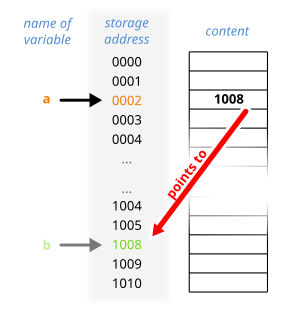
C is a general-purpose computer programming language. It was created in the 1970s by Dennis Ritchie, and remains very widely used and influential. By design, C's features cleanly reflect the capabilities of the targeted CPUs. It has found lasting use in operating systems, device drivers, protocol stacks, though decreasingly for application software. C is commonly used on computer architectures that range from the largest supercomputers to the smallest microcontrollers and embedded systems.
In computing, a segmentation fault or access violation is a fault, or failure condition, raised by hardware with memory protection, notifying an operating system (OS) the software has attempted to access a restricted area of memory. On standard x86 computers, this is a form of general protection fault. The operating system kernel will, in response, usually perform some corrective action, generally passing the fault on to the offending process by sending the process a signal. Processes can in some cases install a custom signal handler, allowing them to recover on their own, but otherwise the OS default signal handler is used, generally causing abnormal termination of the process, and sometimes a core dump.
In computing, an optimizing compiler is a compiler that tries to minimize or maximize some attributes of an executable computer program. Common requirements are to minimize a program's execution time, memory footprint, storage size, and power consumption.
Java and C++ are two prominent object-oriented programming languages. By many language popularity metrics, the two languages have dominated object-oriented and high-performance software development for much of the 21st century, and are often directly compared and contrasted. Java appeared about 10 years later and its syntax was based on C/C++.
In programming languages, a closure, also lexical closure or function closure, is a technique for implementing lexically scoped name binding in a language with first-class functions. Operationally, a closure is a record storing a function together with an environment. The environment is a mapping associating each free variable of the function with the value or reference to which the name was bound when the closure was created. Unlike a plain function, a closure allows the function to access those captured variables through the closure's copies of their values or references, even when the function is invoked outside their scope.
In computer programming, a type system is a logical system comprising a set of rules that assigns a property called a type to every "term". Usually the terms are various constructs of a computer program, such as variables, expressions, functions, or modules. A type system dictates the operations that can be performed on a term. For variables, the type system determines the allowed values of that term. Type systems formalize and enforce the otherwise implicit categories the programmer uses for algebraic data types, data structures, or other components.
In object-oriented programming (OOP), the object lifetime of an object is the time between an object's creation and its destruction. Rules for object lifetime vary significantly between languages, in some cases between implementations of a given language, and lifetime of a particular object may vary from one run of the program to another.
The syntax of the C programming language is the set of rules governing writing of software in the C language. It is designed to allow for programs that are extremely terse, have a close relationship with the resulting object code, and yet provide relatively high-level data abstraction. C was the first widely successful high-level language for portable operating-system development.

In computer science, a pointer is an object in many programming languages that stores a memory address. This can be that of another value located in computer memory, or in some cases, that of memory-mapped computer hardware. A pointer references a location in memory, and obtaining the value stored at that location is known as dereferencing the pointer. As an analogy, a page number in a book's index could be considered a pointer to the corresponding page; dereferencing such a pointer would be done by flipping to the page with the given page number and reading the text found on that page. The actual format and content of a pointer variable is dependent on the underlying computer architecture.
In computer programming, undefined behavior (UB) is the result of executing a program whose behavior is prescribed to be unpredictable, in the language specification to which the computer code adheres. This is different from unspecified behavior, for which the language specification does not prescribe a result, and implementation-defined behavior that defers to the documentation of another component of the platform.
In computer science, type safety and type soundness are the extent to which a programming language discourages or prevents type errors. Type safety is sometimes alternatively considered to be a property of facilities of a computer language; that is, some facilities are type-safe and their usage will not result in type errors, while other facilities in the same language may be type-unsafe and a program using them may encounter type errors. The behaviors classified as type errors by a given programming language are usually those that result from attempts to perform operations on values that are not of the appropriate data type, e.g., adding a string to an integer when there's no definition on how to handle this case. This classification is partly based on opinion.
In computing, aliasing describes a situation in which a data location in memory can be accessed through different symbolic names in the program. Thus, modifying the data through one name implicitly modifies the values associated with all aliased names, which may not be expected by the programmer. As a result, aliasing makes it particularly difficult to understand, analyze and optimize programs. Aliasing analysers intend to make and compute useful information for understanding aliasing in programs.
A struct in the C programming language is a composite data type declaration that defines a physically grouped list of variables under one name in a block of memory, allowing the different variables to be accessed via a single pointer or by the struct declared name which returns the same address. The struct data type can contain other data types so is used for mixed-data-type records such as a hard-drive directory entry, or other mixed-type records.
In the C++ programming language, a reference is a simple reference datatype that is less powerful but safer than the pointer type inherited from C. The name C++ reference may cause confusion, as in computer science a reference is a general concept datatype, with pointers and C++ references being specific reference datatype implementations. The definition of a reference in C++ is such that it does not need to exist. It can be implemented as a new name for an existing object.
In some programming languages, const is a type qualifier that indicates that the data is read-only. While this can be used to declare constants, const in the C family of languages differs from similar constructs in other languages in being part of the type, and thus has complicated behavior when combined with pointers, references, composite data types, and type-checking. In other languages, the data is not in a single memory location, but copied at compile time on each use. Languages which utilize it include C, C++, D, JavaScript, Julia, and Rust.
In computer programming, a forward declaration is a declaration of an identifier for which the programmer has not yet given a complete definition.
In compiler optimization, escape analysis is a method for determining the dynamic scope of pointers – where in the program a pointer can be accessed. It is related to pointer analysis and shape analysis.
C++11 is a version of the ISO/IEC 14882 standard for the C++ programming language. C++11 replaced the prior version of the C++ standard, called C++03, and was later replaced by C++14. The name follows the tradition of naming language versions by the publication year of the specification, though it was formerly named C++0x because it was expected to be published before 2010.
Memory ordering describes the order of accesses to computer memory by a CPU. The term can refer either to the memory ordering generated by the compiler during compile time, or to the memory ordering generated by a CPU during runtime.
In computer programming, a constant is a value that should not be altered by the program during normal execution, i.e., the value is constant. When associated with an identifier, a constant is said to be "named," although the terms "constant" and "named constant" are often used interchangeably. This is contrasted with a variable, which is an identifier with a value that can be changed during normal execution, i.e., the value is variable.






